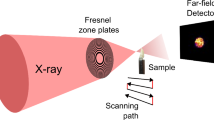Abstract
During the development of a novel photoconductive digital medical X-ray imaging device, we performed transient photoconductive measurements of both electrons and holes in a-Se structures that were either of a sandwich or co-planar structure. In sandwich type measurements, carriers move through the bulk away from interfaces. In co-planar structures, carriers move near an interface. The photoconductive properties of a-Se have been extensively characterised, using photoconductive time-of-flight (TOF) methods. These measurements have been performed using sandwich structures consisting of a-Se deposited on a bottom conducting substrate and a top thin semi-transparent biasing electrode. A weak, brief (compared to transit times) light pulse is applied to the semi-transparent electrode and the resulting photoconductive transient current pulse is used to determine carrier properties. In a-Se medical X-ray applications, the a-Se layer is quite thick (150–500 \(\upmu\)m) causing long carrier transit times. We were interested in reducing these long photoconductive transit (readout) times by instead moving the collected image charges comparatively short distances (10–20 \(\upmu\)m) laterally between co-planar image pixel electrodes and neighbouring readout electrodes. In the exploration of this concept, we studied experimentally the transient photoconductivity of co-planar a-Se structures. We found, unexpectedly, the transient photoconductivity measurements of the co-planar structures to be quite different from those of the sandwich (bulk) type. We concluded that the co-planar a-Se photoconductivity was totally dominated by a high density of interface trapping states. It is recommended that the measurement of bulk carrier properties via TOF using co-planar structures carefully take into account interface states.












Similar content being viewed by others
References
H.K. Kim, I.A. Cunningham, Z. Yin, G. Cho, On the development of digital radiography detectors: a review. Int. J. Precis. Eng. Manuf. 9(4), 86–100 (2008)
D.M. Hunter, Digital radiography by laser scanned readout of amorphous selenium. Master’s thesis, University of Toronto (1996)
N. Reznik, P.T. Komljenovic, S. Germann, J.A. Rowlands, Digital radiography using amorphous selenium: photoconductively activated switch (PAS) readout system. Med. Phys. 35, 1039–1050 (2008)
J.W. Boag, Xeroradiography. Phys. Med. Biol. 18, 3–37 (1973)
J.R. Haynes, W. Shockley, The mobility and life of injected holes and electrons in germanium. Phys. Rev. 81, 835 (1951)
E. Hecht, Optics (Addison-Wesley, Reading, 1987)
M. Griot, Introduction to Gaussian Beam Optics (1995/1996)
H.A. Haus, J.R. Melcher, Electromagnetic Fields and Energy (Prentice Hall, Englewood Cliffs, 1989)
R.F. Harrington, Field Computation by Moment Methods (MacMillan, New York, 1968)
C.A. Brebbia, J. Dominguez, Boundary Elements (McGraw-Hill, New York, 1988)
N.F. Mott, E.A. Davis, Electronic Processes in Non-crystalline Materials, 2nd edn. (Oxford University Press, Oxford, 1979)
Ig VonTamm, Uber eine mogliche art der electronenbindung an kristalloberflachen. Z. Phys. Sowjetunion 1, 733–746 (1932)
W. Shockley, On the surface states associated with a periodic potential. Phys. Rev. 56, 317–323 (1939)
B.M. Bolotovskii, V.Y. Frenkel. I.E. Tamm Selected Papers. (Springer, Berlin, 1991)
R.M. Schaffert, Electrophotography, 2nd edn. (Focal Press Ltd., London, 1975)
D.M. Pai, R.C. Enck, Onsager mechanisms of photogeneration in amorphous selenium. Phys. Rev. B 11, 5163–5174 (1975)
W.F. Ames, Numerical Methods for Partial Differential Equations, 3rd edn. (Academic Press, New York, 1992)
W.H. Press, S.A. Teukolsky, W.T. Vetterling, B.P. Flannery, Numerical Recipes in C, 2nd edn. (Cambridge University Press, Cambridge, 1992)
S.M. Sze, Physics of Semiconductor Devices, 2nd edn. (John Wiley & Sons, New York, 1981)
J.A. Rowlands, D.M. Hunter, N. Araj, X-ray imaging using amorphous selenium: a photoinduced discharge readout method for digital mammography. Med. Phys. 18, 421–431 (1991)
J.A. Rowlands, D.M. Hunter, X-ray imaging using amorphous selenium: photoinduced discharge (PID) readout for digital radiography. Med. Phys. 22, 1983–1996 (1996)
S.O. Kasap, Transient photoconductivity measurements on halogenated a-Se\(_{1-x}\)T\(_{x}\) photoconductors. Can. J. Phys. 67, 1053 (1989)
S.O. Kasap, C. Juhasz, Time of flight drift mobility measurements on chlorine-doped amorphous selenium films. J. Phys. D. 18, 703–720 (1985)
T. Yoshikawa, T. Nagase, T. Kobayashi, S. Murakami, H. Naito, Analysis of time-of-flight transient photocurrent in organic semiconductors with coplanar-blocking-electrodes configuration. Thin Film Solid Films 516, 2595–2599 (2008)
G. Bratin, E. Pavlica, Characterisation of charge carrier transport in thin organic semiconductor layers by time-of-flight photocurrent measurements. Org. Electron. 64, 117–130 (2019)
N. Qamhieh, M.L. Benkhedir, M. Brinza, G.J. Adriaenssens, Low-temperature steady-state photoconductivity in amorphous selenium films. J. Optoelectron. Adv. Mater. 7(4), 1781–1784 (2005)
F. Serdouk, M. Benkhedir, Density of states in pure and as doped amorphous selenium determined from transient photoconductivity using Laplace-transform method. Physica B 459, 122–128 (2015)
S. Kasap, C. Koughia, J. Berashevich, R. Johanson, A. Reznik, Charge transport in pure and stablized amorphous selenium: re-examination of the density of states distribution in the mobility gap and the role of defects. J. Mater. Sci. 26, 4644–4658 (2015)
Author information
Authors and Affiliations
Corresponding author
Additional information
Publisher's Note
Springer Nature remains neutral with regard to jurisdictional claims in published maps and institutional affiliations.
Rights and permissions
About this article
Cite this article
Hunter, D.M., Rowlands, J.A. Differences between transient photoconductivity in a-Se sandwich(bulk) and co-planar(interface) structures. J Mater Sci: Mater Electron 31, 9114–9125 (2020). https://doi.org/10.1007/s10854-020-03441-4
Received:
Accepted:
Published:
Issue Date:
DOI: https://doi.org/10.1007/s10854-020-03441-4




